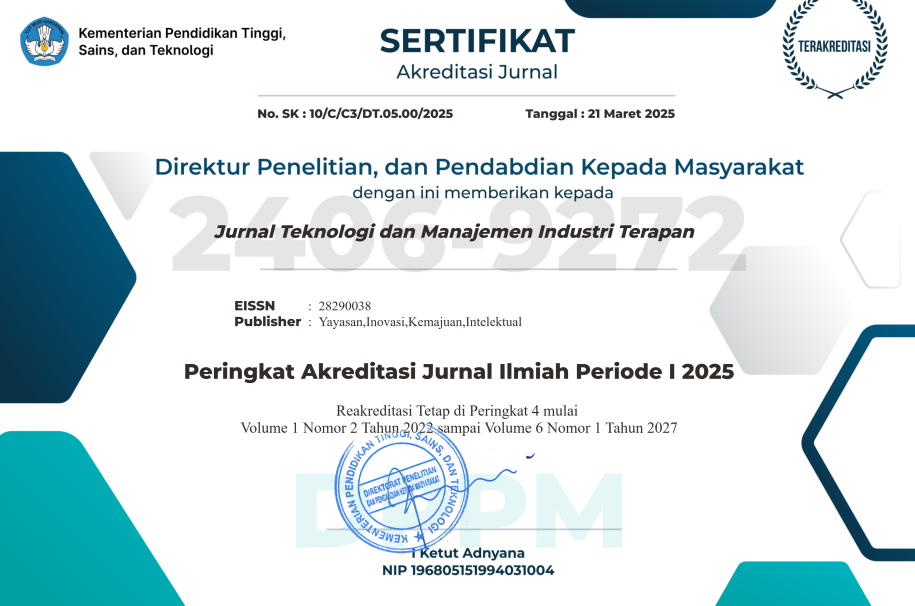Self-Efficacy And Communication Strategies For Blind Disability Entrepreneurs In Increasing Business Independence
DOI:
https://doi.org/10.55826/jtmit.v4iI.1136Keywords:
Communication, Entrepreneurship, Blindness, Independence, BusinessAbstract
The limited accessibility of information, technology, and public perception is an obstacle in developing the entrepreneurship of business actors with visual disabilities. Therefore, it is essential to explore communication strategies that can increase the involvement and independence of the visually impaired in the business world, especially the development of Al-Quran braille as part of literacy. This research aims to analyse self-efficacy and explore effective entrepreneurial communication strategies for the visually impaired, focusing on increasing their engagement and independence in business. Another goal is understanding the challenges the visually impaired face in business communication. This research method uses a qualitative approach by conducting in-depth interviews, observations, and document analysis of the visually impaired in entrepreneurship. This research resulted in a deeper understanding of self-efficacy and effective entrepreneurial communication strategies for the visually impaired. Positive self-efficacy can help determine the proper coping techniques to cope with the stress they are experiencing. In addition, this study found that effective communication strategies are essential to improve business independence for people with visual disabilities. These strategies include communicating positively, openly, and optimistically and emulating the spirit of achievement shown by friends with visual disabilities. The research provides practical guidance for the visually impaired who want to be involved in the business world and provides insight for business people and the general public to create an inclusive environment for the visually impaired in entrepreneurship in Al-Quran braille literacy.References
R.Shafer-Landau, Moral Realism: A Defence. 2003. Doi: 10.1093/0199259755.001.0001.
M. R.Franco, “Older People’s Perspectives On Participation In Physical Activity: A Systematic Review And Thematic Synthesis Of Qualitative Literature,” 2015. Doi: 10.1136/Bjsports-2014-094015.
M. P.Leiter, “Latent Burnout Profiles: A New Approach To Understanding The Burnout Experience,” Burn. Res., Vol. 3, No. 4, Pp. 89–100, 2016, Doi: 10.1016/J.Burn.2016.09.001.
J.Morente-Sánchez, “Doping In Sport: A Review Of Elite Athletes’ Attitudes, Beliefs, And Knowledge,” 2013. Doi: 10.1007/S40279-013-0037-X.
M.Vagni, “Coping With Covid-19: Emergency Stress, Secondary Trauma And Self-Efficacy In Healthcare And Emergency Workers In Italy,” Front. Psychol., Vol. 11, 2020, Doi: 10.3389/Fpsyg.2020.566912.
J. J.Kennedy, “From The Tax-For-Fee Reform To The Abolition Of Agricultural Taxes: The Impact On Township Governments In North-West China,” 2007. Doi: 10.1017/S0305741006000798.
V.Pérez-Jover, “Mobile Apps For Increasing Treatment Adherence: Systematic Review,” 2019. Doi: 10.2196/12505.
J. W.Molling, “Cd4+Cd25hi Regulatory T-Cell Frequency Correlates With Persistence Of Human Papillomavirus Type 16 And T Helper Cell Responses In Patients With Cervical Intraepithelial Neoplasia,” Int. J. Cancer, Vol. 121, No. 8, Pp. 1749–1755, 2007, Doi: 10.1002/Ijc . 22894.
R. E.Wells, “Effectiveness Of Mindfulness Meditation Vs Headache Education For Adults With Migraine: A Randomised Clinical Trial,” Jama Intern. Med.., Vol. 181, No. 3, Pp. 317–328, 2021, Doi: 10.1001/Jamainternmed.2020.7090.
A.Ceraso, “Maintenance Treatment With Antipsychotic Drugs For Schizophrenia,” 2020. Doi: 10.1002/14651858.Cd008016.Pub3.
M.Brengman, “Segmenting Internet Shoppers Based On Their Web-Usage-Related Lifestyle: A Cross-Cultural Validation,” J. Bus. Res., Vol. 58, No. 1, Pp. 79–88, 2005, Doi: 10.1016/S0148-2963(02)00476-9.
H.Cigdem, “Predictors Of Instructors’ Behavioural Intention To Use Learning Management System: A Turkish Vocational College Example,” Comput. Human Behav., Vol. 52, Pp. 22–28, 2015, Doi: 10.1016/J.Chb.2015.05.049.
I. S.Radzishevsky, “Effects Of Acyl Versus Aminoacyl Conjugation On The Properties Of Antimicrobial Peptides,” Antimicrob. Agents Chemother., Vol. 49, No. 6, Pp. 2412–2420, 2005, Doi: 10.1128/Aac.49.6.2412-2420.2005.
C.Rubino, “How Do Stressors Lead To Burnout? The Mediating Role Of Motivation,” J. Occup. Health Psychol., Vol. 14, No. 3, Pp. 289–304, 2009, Doi: 10.1037/A0015284.
F. J.Hlubocky, “Addressing Burnout In Oncology: Why Cancer Care Clinicians Are At Risk, What Individuals Can Do, And How Organisations Can Respond,” Am. Soc. Clin. Oncol. Educ. B. Am. Soc. Clin. Oncol. Meet., Vol. 35, Pp. 271–279, 2016, Doi: 10.14694/Edbk_156120.
V. Corral-Verdugo, “Personal Normative Beliefs, Antisocial Behaviour, And Residential Water Conservation,” Environ. Behav., Vol. 38, No. 3, Pp. 406–421, 2006, Doi: 10.1177/0013916505282272.
K. B.Yusuff, “Adherence To Anti-Diabetic Drug Therapy And Self-Management Practices Among Type-2 Diabetics In Nigeria,” Pharm. World Sci., Vol. 30, No. 6, Pp. 876–883, 2008, Doi: 10.1007/S11096-008-9243-2.
H.Bang, “Examining The Role Of Cynicism In The Relationships Between Burnout And Employee Behaviour,” Rev. Psicol. Del Trab. Y Las Organ., Vol. 33, No. 3, Pp. 217–227, 2017, Doi: 10.1016/J.Rpto.2017.07.002.
S.Kool, “Efficacy Of Combined Therapy And Pharmacotherapy For Depressed Patients With Or Without Personality Disorders,” Harv. Rev. Psychiatry, Vol. 11, No. 3, Pp. 133–141, 2003, Doi: 10.1080/10673220303950.
S.Scarpato, “Patient Preferences In The Choice Of Anti-Tnf Therapies In Rheumatoid Arthritis. Results From A Questionnaire Survey (Riviera Study),” Rheumatology, Vol. 49, No. 2, Pp. 289–294, 2010, Doi: 10.1093/Rheumatology/Kep354.
K.Schabram, “How Other- And Self-Compassion Reduce Burnout Through Resource Replenishment,” Acad. Manag. J., Vol. 65, No. 2, Pp. 453–478, 2022, Doi: 10.5465/Amj.2019.0493.
J.Peuskens, “Effects Of Risperidone On Affective Symptoms In Patients With Schizophrenia,” Int. Clin. Psychopharmacol., Vol. 15, No. 6, Pp. 343–349, 2000, Doi: 10.1016/S0924-977x(98)80414-8.
K.Han, “Functional Peptide-Based Nanoparticles For Photodynamic Therapy,” 2017. Doi: 10.1039/C7tb02804k.
Downloads
Published
How to Cite
Issue
Section
License
Copyright (c) 2025 Fachmi Ibrahim, Tarsani, Resman Maharul Tambunan, Nachua Biyan Aprita, Al Maidatuz Zuhruf

This work is licensed under a Creative Commons Attribution-NonCommercial-ShareAlike 4.0 International License.


















